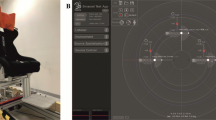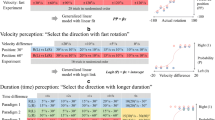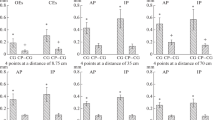Abstract
Vestibular perception of whole-body passive rotation in the horizontal plane was studied by applying two-dimensional (2D) motion to eight blindfolded healthy volunteers: pure rotations in place, corner-like trajectories and arcs of a circular trajectory were randomly applied by means of a remotely controlled robot. Angles embedded in the 2D trajectories were 45°, 90°, 135° and 180°. Stimulation of semicircular canals was the same for all trajectories but was accompanied by concurrent otolith stimulation during circular motion. Subjects participated in two successive experimental sessions. In the first session they were instructed to use a pointer to reproduce the total angular displacement after the motion (REPRODUCTION); in the second session they had to keep pointing towards a remote (15 m) memorised target during the motion (TRACKING). In REPRODUCTION subjects tended to overestimate their rotation angle by 28 ± 11% (mean ± SD). There was no systematic effect of the trajectory. Overestimation also occurred when subjects were required to rotate in darkness by 180° (by controlling a joystick). In TRACKING there was virtually no overestimation (6 ± 17%) and the movement of the pointer matched the dynamics of angular motion. We conclude that (a) the brain can separate and memorise the angular component of complex 2D motion; however, a large inter-individual variability in estimating its amplitude exists; (b) in the range of linear accelerations used in the study, no appreciable effect of otolith-canal perceptual interaction was shown; (c) angular displacements can be dynamically transformed into matched pointing movements; (d) overestimation seems to be typical of delayed judgements of angular displacement and of self-controlled rotations in place. This could be due to the characteristics of the physiological calibration of the vestibular input.
Similar content being viewed by others
Author information
Authors and Affiliations
Additional information
Received: 30 October 1996 / Accepted: 18 June 1997
Rights and permissions
About this article
Cite this article
Ivanenko, Y., Grasso, R., Israël, I. et al. Spatial orientation in humans: perception of angular whole-body displacements in two-dimensional trajectories. Exp Brain Res 117, 419–427 (1997). https://doi.org/10.1007/s002210050236
Issue Date:
DOI: https://doi.org/10.1007/s002210050236




